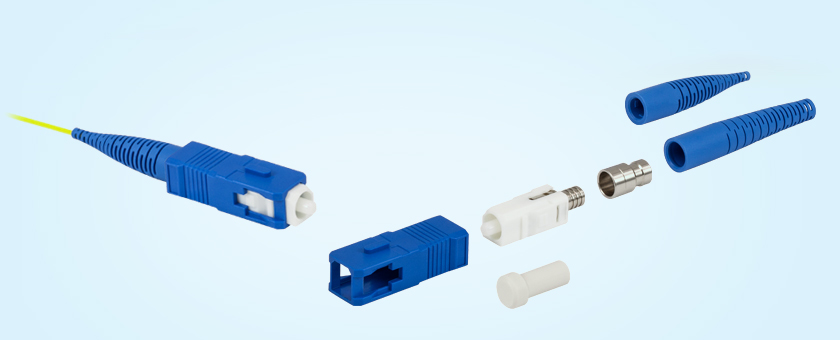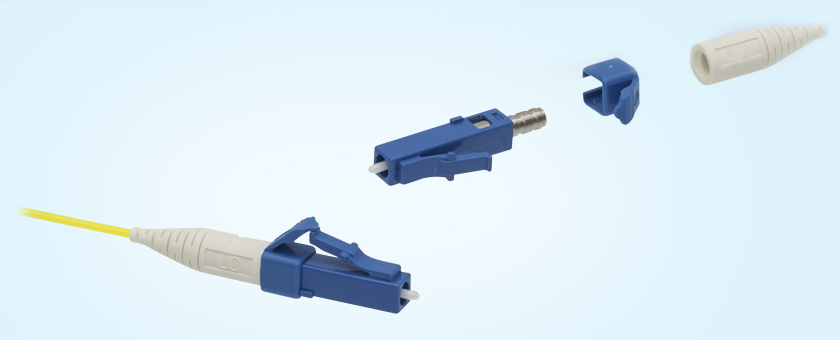දත්ත මධ්යස්ථානවල ජාල උපාංග අතර සම්බන්ධ කිරීම සඳහා සහ සම්බන්ධ කිරීම සඳහා දෘශ්ය සම්බන්ධක භාවිතා වේෆයිබර් ඔප්ටික් කේබල්පාරිභෝගික පරිශ්රයේ ඇති උපකරණ වෙත (උදා. FTTH).විවිධ වර්ගයේ ෆයිබර් සම්බන්ධක අතර, SC සහ LC බහුලව භාවිතා වන සම්බන්ධක දෙකකි.SC එදිරිව LC: වෙනස කුමක්ද සහ වඩා හොඳ කුමක්ද?ඔබට තවමත් පිළිතුරක් නොමැති නම්.ඔබට මෙහි යම් ඉඟියක් සොයාගත හැකිය.

SC සම්බන්ධකය යනු කුමක්ද?
අසූව දශකයේ මැද භාගයේ Nippon Telegraph සහ Telephone (NTT) හි රසායනාගාර විසින් වැඩි දියුණු කරන ලද, SC සම්බන්ධකය සෙරමික් ෆෙරුල් පැමිණීමෙන් පසු වෙළඳපොළට පැමිණි පළමු සම්බන්ධක වලින් එකකි.සමහර විට "චතුරස්ර සම්බන්ධකය" ලෙසින් හඳුන්වනු ලබන SC හි වසන්ත පටවන ලද සෙරමික් ෆෙරුලයක් සහිත තල්ලු-අදින්න සම්බන්ධක අවසන් මුහුණක් ඇත.Gigabit Ethernet ජාලකරණය සඳහා මුලින් අදහස් කරන ලද එය 1991 දී විදුලි සංදේශ පිරිවිතර TIA-568-A වෙත ප්රමිතිගත කරන ලද අතර නිෂ්පාදන පිරිවැය පහත වැටීමත් සමඟ සෙමින් ජනප්රියත්වයට පත්විය.එහි විශිෂ්ට කාර්ය සාධනය හේතුවෙන් එය දශකයකට වැඩි කාලයක් ෆයිබර් ඔප්ටික්ස් ආධිපත්යය දැරූ අතර එය සමඟ තරඟ කළේ ST පමණි.වසර තිහකට පසු, එය ධ්රැවීකරණය පවත්වාගෙන යාමේ යෙදුම් සඳහා දෙවන වඩාත් පොදු සම්බන්ධකය ලෙස පවතී.ලක්ෂ්ය සහ අක්රීය දෘශ්ය ජාලකරණය ඇතුළුව දත්ත කොම් සහ ටෙලිකොම් යෙදුම් සඳහා SC ඉතා සුදුසු වේ.
LC සම්බන්ධකය යනු කුමක්ද?

SC සම්බන්ධකයේ නවීන ප්රතිස්ථාපනය ලෙස ඇතැමුන් විසින් සලකනු ලබන අතර, LC සම්බන්ධකය හඳුන්වාදීම අඩු සාර්ථක වූයේ, නව නිපැයුම්කරු ලුසන්ට් කෝපරේෂන් වෙතින් මුලින් බලපත්ර ගාස්තු ඉහළ මට්ටමක පැවතීම හේතුවෙනි.තල්ලු-අදින්න සම්බන්ධකයක් ලෙසද, LC SC අගුලු දැමීමේ ටැබයට ප්රතිවිරුද්ධව අගුලක් භාවිතා කරන අතර කුඩා ෆෙරුලයක් සමඟ එය කුඩා ආකෘති සාධක සම්බන්ධකයක් ලෙස හැඳින්වේ.SC සම්බන්ධකයේ අඩිපාරෙන් අඩක් තිබීම එය Datacoms සහ අනෙකුත් අධි-ඝනත්ව පැච් යෙදුම්වල විශාල ජනප්රියත්වයක් ලබා දෙයි, මන්ද එහි කුඩා ප්රමාණයේ සහ අගුලේ විශේෂාංගයේ සංයෝජනය එය ජනාකීර්ණ රාක්ක/පැනල් සඳහා වඩාත් සුදුසු වේ.LC අනුකූල ට්රාන්ස්සීවර් සහ සක්රීය ජාලකරණ සංරචක හඳුන්වාදීමත් සමඟ, FTTH ක්ෂේත්රයේ එහි ස්ථාවර වර්ධනය දිගටම පවතිනු ඇත.
SC එදිරිව LC: ඔවුන් එකිනෙකාගෙන් වෙනස් වන්නේ කෙසේද?

SC සහ LC සම්බන්ධකය යන දෙකම පිළිබඳ මූලික අවබෝධයක් ලබා ගැනීමෙන් පසුව, ඔබට වෙනස්කම් මොනවාද සහ ඒවා ඔබගේ ක්රියාත්මක කිරීමට අදහස් කරන්නේ කුමක්දැයි විමසිය හැක.පහත වගුවේ ශක්තීන් සහ දුර්වලතා පිළිබඳ දළ විශ්ලේෂණයක් ලබා දේ.සාමාන්යයෙන් කථා කරන විට, LC සහ SC ෆයිබර් ඔප්ටික් සම්බන්ධකය අතර වෙනස පවතින්නේ ප්රමාණය, හැසිරවීම සහ සම්බන්ධක ඉතිහාසය තුළ වන අතර එය පිළිවෙළින් පහත පාඨයෙන් සාකච්ඡා කෙරේ.
- ප්රමාණය: LC SC ප්රමාණයෙන් අඩකි.ඇත්ත වශයෙන්ම, එක් SC-ඇඩැප්ටරයක් duplex LC-ඇඩැප්ටරයක ප්රමාණයට සමාන වේ.එබැවින් ඇසුරුම් ඝනත්වය (ප්රදේශයකට සම්බන්ධතා ගණන) වැදගත් පිරිවැය සාධකයක් වන මධ්යම කාර්යාලවල LC බහුලව දක්නට ලැබේ.
- හැසිරවීම: SC යනු සැබෑ “තල්ලු-අදින්න-සම්බන්ධකයක්” වන අතර LC යනු “අගුළු දැමූ සම්බන්ධකයක්” වේ, නමුත් SC වැනි එකම හැසිරවීමේ හැකියාවන් ඇති ඉතා නව්ය, සැබෑ “පුෂ්-පුල්-එල්සී” තිබේ.
- සම්බන්ධකයේ ඉතිහාසය: LC යනු දෙකේ “තරුණ” සම්බන්ධකයයි, SC ලොව පුරා පුළුල්ව පැතිරී ඇති නමුත් LC අල්ලා ගනිමින් සිටී.සම්බන්ධක දෙකෙහිම ඇතුළත් කිරීමේ අලාභය සහ ප්රතිලාභ අහිමි වීමේ හැකියාව ඇත.සාමාන්යයෙන්, එය රඳා පවතින්නේ ඔබට සම්බන්ධකය භාවිතා කිරීමට අවශ්ය ජාලයේ කොතැනද යන්න, SC හෝ LC නොතකා, වෙනත් විවිධ සම්බන්ධක පවා.
සාරාංශය
වර්තමාන සහ අනාගත සන්නිවේදන තාක්ෂණය දත්ත සන්නිවේදන ක්රියාවලියේ වේගවත්, කාර්යක්ෂම සහ ආරක්ෂිත කාර්ය සාධනයක් ඉල්ලා සිටී.අන්තර් සම්බන්ධිත විශාල සහ සංකීර්ණ දත්ත සමුදායන් බාහිර බාධාවකින් තොරව දත්ත ලබා ගැනීමට සහ සම්ප්රේෂණය කිරීමට හැකි විය යුතුය.SC සහ LC යන දෙකම එවැනි ආකාරයේ සම්ප්රේෂණයක් ලබා ගැනීමට සැලසුම් කර ඇත.“SC එදිරිව LC: වෙනස කුමක්ද සහ වඩා හොඳ කුමක්ද?” යන ප්රශ්නය සඳහා, ඔබ මූලික කරුණු තුනක් මතක තබා ගත යුතුය: 1. SC සතුව විශාල සම්බන්ධක නිවාසයක් සහ විශාල 2.5mm ෆෙරූල් ඇත.2. LC කුඩා සම්බන්ධක නිවාසයක් සහ කුඩා 1.25mm ferrule ඇත.3. ඉස්සර නම් SC කියන්නේ හැමෝගෙම තරහක්, නමුත් දැන් ඒක LC.ඔබට LC සම්බන්ධකය සමඟ රේඛීය කාඩ්පත්, පැනල් ආදියෙහි තවත් අතුරු මුහුණත් සවි කළ හැක.
පසු කාලය: නොවැම්බර්-29-2021

